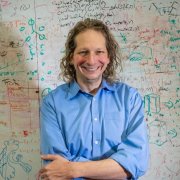R&D Magazine is proud to announce Josh Tenenbaum, PhD, a computational cognitive scientist at Massachusetts Institute of Technology (MIT), as the 2018 Innovator of the Year. Tenenbaum was honored for his work studying the nature and origins of intelligence in the human mind and brain and applying that knowledge to build more human-like intelligence in machines.
A full feature on Tenenbaum’s accomplishments will be featured in the December 2018 issue of R&D Magazine.
“We selected Josh as our 2018 Innovator of the Year not only because of his accomplishments in the fields of cognitive science and artificial intelligence, but because of his willingness to partner with experts across the board—from computer scientists and engineers to neuroscientists and cognitive psychologists—in the name of innovation,” said Bea Riemschneider, Editorial Director, R&D Magazine. “His work is bridging the gap between two seemingly distinct fields.”
Tenenbaum remotely accepted his award via a video message at the 2018 R&D 100 Awards black-tie ceremony, held Nov. 16, 2018, at the Waldorf Astoria Orlando. The same event also recognized the 2018 R&D 100 Award winners as well as R&D Magazine’s 2018 Scientist of the Year, Los Alamos National Laboratory (LANL) theoretical biologist and HIV researcher Bette Korber, PhD.
Tenenbaum is a Professor of Computational Cognitive Science in the Department of Brain and Cognitive Sciences at MIT, and a member of MIT's Computer Science and Artificial Intelligence Laboratory (CSAIL) and Center for Brains, Minds and Machines (CBMM). He also leads the Computational Cognitive Science lab at MIT and is a leader of a major new AI project known as the MIT Quest for Intelligence.
Much of Tenenbaum’s research focuses on the minds of children, where his goal is to gain a better understanding of how we first develop the ability to learn so much about the world, rapidly and flexibly. He has explored how even small children are able to visualize aspects of the world using a kind of innate 3D model, an ability that s gives humans a greater instinctive understanding of the physical world than a computer or robot has.
Through a combination of mathematical modeling, computer simulation and behavioral experiments, his team works to uncover the logic behind our everyday inductive leaps: constructing perceptual representations, separating “style” and “content” in perception, learning concepts and words, judging similarity or representativeness, inferring causal connections, noticing coincidences, and predicting the future.
His scientific work currently focuses on two areas: describing the structure, content, and development of people’s commonsense theories, especially intuitive physics and intuitive psychology, and understanding how people are able to learn and generalize new concepts, models, theories and tasks from very few examples—often called "one-shot learning.” He and his team have been able to recreate “one-shot learning” artificially, designing computer programs capable of learning to recognize new handwritten characters, as well as certain objects in images, after seeing just a few examples. This ability could allow future machine-learning programs to work much more efficiently, learning quickly from minimal examples instead of requiring huge quantities of training data.
---
Follow link below to read full article on the R&D website.

